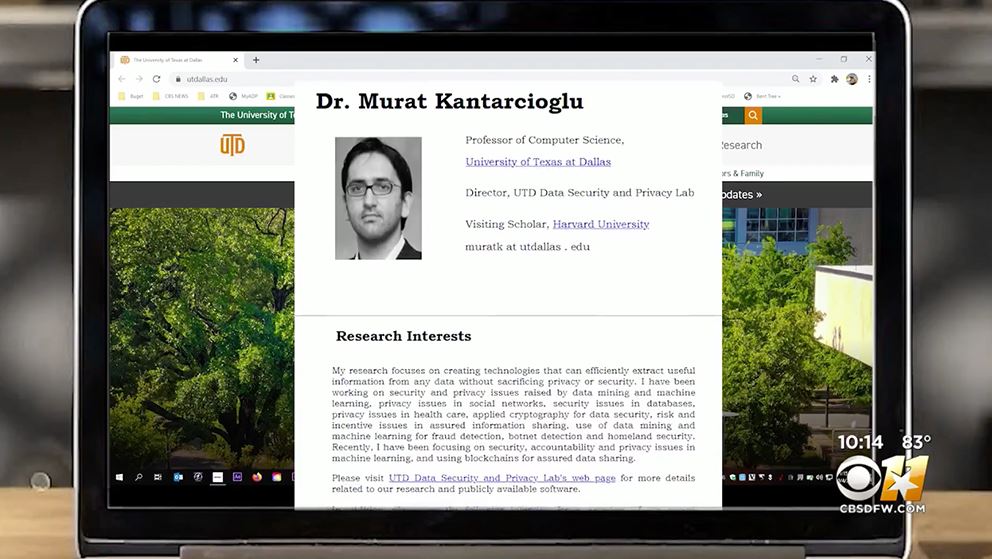Dr. Kantarcioglu Talks With CBS DFW I-Team About Online Safety For Kids In The Virtual Classroom

Via CBSDFW.COM – In registering children for the new school year, parents probably read, and maybe signed, a routine photo release form about schools posting images of their students on social media sites.
But the CBS 11 I-Team discovered a big difference this year.
The social media images that teachers may be posting are now coming from inside students’ homes.
They may be coming from inside a child’s bedroom. And they may have a child’s name on his or her face.
A concerned parent emailed the I-Team saying, “Top administrators publicly post images to social media of sleepy kindergartners in their bedrooms along with their full name, school and the web address to their virtual classrooms.”
The I-Team showed similar photos to Dr. Murat Kantarcioglu, a professor at the University of Texas at Dallas with expertise in privacy.
“It could be dangerous,” said Dr. Kantarcioglu. “I can see the pictures, schools and their names. From there, I can check websites and figure out where they are teaching and which classes. In some cases, I have the student’s surnames and sometimes their parent’s emails.”
Using public records, he says a savvy stranger could learn more.
“I don’t see the benefit of sharing this so why take the risk,” says Dr. Kantarcioglu.
The I-Team reached out to 14 of the largest North Texas school districts. Eleven responded.
The policies all stated that parents must sign a photo and/or directory information release form before information can be released or posted.
But the I-Team learned what parents sign varies a lot from district to district.
Directory information may include a child’s address, date and place of birth, activities, even the child’s height and weight.
Keller ISD’s policy states it can disclose all of that information with parental permission.
Frisco ISD’s policy states the district cannot share a photo if the student’s grade or name or course is on it.
The policy at Plano ISD states teachers cannot share on their personal sites at all.
Richardson ISD states it will only publish photos or student information, with a parent’s permission, on school or district sites.
Grand Prairie and Mesquite ISD both require a teacher to get written permission from a supervisor before posting anything.
The policy in Lewisville ISD gives parents two options: (1) to release photos strictly for school purposes, or (2) to third party vendors “not affiliated” with the school.
Despite the policies, insiders say the old regulations that parents have been signing for years, are nowhere near catching up with the new reality of online school this year.
“Because all of this is so new,” says Steve Balkam, the founder of the Family Online Safety Institute. “We’re making up the rules as we go along.”
Balkam’s foundations works with lawmakers to help protect children online.
“Teachers and school districts and principals and parents must be acutely aware of how their children’s images are being used,” says Balkam. “Perhaps in the background, there is a picture of their house or the name of their street or the ballet class they go to at 4 o’clock.”
A year ago, most districts had constant conversations about ways to lock schools down and protect children from intruders, shooters and other dangers.
Privacy security experts say now is the time to think about the “locked doors, barriers and vestibules” of the virtual world.
Ways to protect your child during online school
- Change your child’s background to a generic one. Some sites provide options to create virtual backgrounds.
- You should always make sure there is a blank wall behind your child. Be sure no one can walk behind or be seen behind him/her.
- Take the email address or name off the screen when they’re in class. If you need to put a name on the screen, use your child’s first name only or his/her initials.
- Turn the camera off if the teacher will allow it.
- Go back and review your school’s privacy policy. Carefully read what you signed and questions if you believe it’s not being applied.
Source | CBS DFW Interview By Ginger Allen
ABOUT THE UT DALLAS COMPUTER SCIENCE DEPARTMENT
The UT Dallas Computer Science program is one of the largest Computer Science departments in the United States with over 3,315 bachelors-degree students, more than 1,110 master’s students, 165 Ph.D. students, 52 tenure-track faculty members, and 44 full-time senior lecturers, as of Fall 2019. With the University of Texas at Dallas’ unique history of starting as a graduate institution first, the CS Department is built on a legacy of valuing innovative research and providing advanced training for software engineers and computer scientists.




